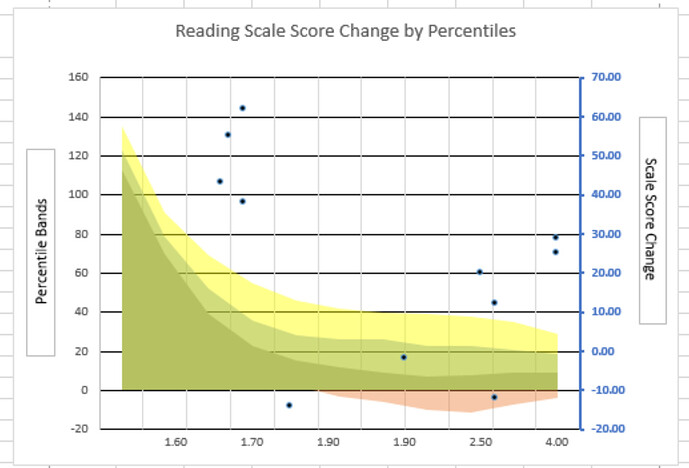I am creating an app that reads a user file to create a scatterplot, and then reads a second file (named "aref" from global.R) to create an area chart as another layer below the scatterplot. Users can subset aref by "domain," thus the second file should be a subset based on input$domain, but I can't make this happen. I get an error "Error: object 'area_data' not found.
The resulting graph should look like this:
How can my scatter+area plot be created with data from the two sources? Please note that my final application will reference a large set of data for the area plot, thus maintaining the global file seems most efficient.
Data for upload file in the app:
upload<-structure(list(X = 1:9, initialReadProficiency = c(1.5, 2, 3,
3.3, 2.5, 6.5, 2.2, 4, 4.2), scalescoreChange = c(22L, 33L, 44L,
44L, 40L, 17L, 28L, 43L, 37L)), class = "data.frame", row.names = c(NA,
-9L))
Data for the Area Plot (should this be set in global.r ? ):
aref<-structure(list(Domain = structure(c(2L, 2L, 2L, 2L, 2L, 2L, 2L,
2L, 2L, 2L, 2L), .Label = c("Math_bogus", "Reading", "Writing_bogus"
), class = "factor"), Grade = structure(c(5L, 5L, 5L, 5L, 3L,
3L, 3L, 3L, 7L, 7L, 7L), .Label = c("Eighth Grade", "Fifth Grade",
"First Grade", "Fourth Grade", "Kindergarten Grade",
"Ninth-Twelfth Grade",
"Second Grade", "Seventh Grade", "Sixth Grade", "Third Grade"
), class = "factor"), Percentile = structure(c(4L, 3L, 2L, 1L,
4L, 3L, 2L, 1L, 4L, 3L, 2L), .Label = c("20th", "40th", "60th",
"80th"), class = "factor"), PL1 = c(188L, 177L, 166L, 145L, 135L,
123L, 113L, 92L, 122L, 106L, 93L), PL15 = c(134L, 117L, 105L,
89L, 91L, 79L, 70L, 51L, 77L, 61L, 47L), PL2 = c(99L, 77L, 60L,
39L, 69L, 52L, 39L, 24L, 58L, 38L, 24L), PL25 = c(87L, 69L, 55L,
35L, 55L, 36L, 23L, 10L, 50L, 30L, 16L), PL3 = c(77L, 59L, 47L,
23L, 46L, 28L, 15L, 2L, 50L, 29L, 14L), PL35 = c(74L, 53L, 41L,
15L, 42L, 26L, 12L, -3L, 48L, 30L, 13L), PL4 = c(73L, 51L, 36L,
11L, 40L, 26L, 9L, -6L, 43L, 28L, 10L), PL45 = c(78L, 52L, 36L,
15L, 39L, 23L, 7L, -10L, 41L, 26L, 12L), PL5 = c(83L, 54L, 37L,
26L, 38L, 23L, 8L, -11L, 41L, 27L, 15L), PL55 = c(88L, 55L, 37L,
34L, 35L, 21L, 9L, -7L, 38L, 25L, 12L), PL6 = c(NA, NA, NA, NA,
29L, 19L, 9L, -4L, 31L, 19L, 8L)), row.names = c(NA, 11L),
class = "data.frame")
Here is my code:
# global
# do I need a global file for this application?
library(ggplot2);library(dplyr);library(readxl)
#aref <- read.csv("//srv/shiny-server/cscShinyApps/DASAareaPlot/statewide.csv")
# prepare data for background area chart
df<-reshape2::melt(data=aref,
id.vars=c("Percentile"),
measure.vars=c("PL1" ,"PL15","PL2","PL25","PL3", "PL35","PL4","PL45" ,"PL5","PL55","PL6"))
# stacked area: one area-shape per `group`
# ggplot(df, aes(variable,value,group=Percentile))+geom_area(alpha=.4)
library(stringr)
df$num<-str_extract(df$variable, "[[:digit:]]+") %>% as.integer()
df$pl_axis <- ifelse(df$num>10,df$num/10,df$num)
df$Percentile<-factor(df$Percentile,levels = c("20th","40th","60th","80th"), ordered = T)
layerArea<-function(){
geom_area(data=area_data,
aes(pl_axis,value,group=Percentile,fill=Percentile),
alpha=.4, position = "dodge")}
#ui
library(shiny);library(plotly);library(ggthemes)
ui<-fluidPage(
titlePanel("Visualize Your Data"),# title
sidebarLayout(
sidebarPanel(column=3, position="left",
fileInput("file1", "STEP 1: Choose CSV File", # Input: Select a file ----
multiple = TRUE,
accept = c("text/csv","text/comma-separated-values,text/plain",".csv")),
checkboxInput("header", "Header", TRUE),# Input: Checkbox if file has header
# Input: Select separator
radioButtons("sep", "Separator",
choices = c(Semicolon = ";",
Comma = ",",Tab = "\t"),
selected = ","),
tags$hr(), # add a Horizontal line
# Input: Select what to display
selectInput("dataset","STEP 2: Choose 'Uploaded File' Here:",choices=list(iris="iris",uploaded_file="inFile"), selected = NULL),
selectInput("x_axis","STEP 3: Choose X-axis variable (initial proficiency):", choices = NULL),
selectInput("y_axis","STEP 4: Choose Y-axis variable (scale score change):", choices = NULL),
selectInput("point_label","STEP 5: Label for points:", choices = NULL),
selectInput("domain","STEP 6: Choose ACCESS Domain:",choices=c("Math_bogus","Reading","Writing_bogus")),
width=4
), # end sidebarPanel ;
fluidRow(column(6, # column width
h3(textOutput("caption")),
#h3(htmlOutput("caption")),
plotlyOutput("finalplot") # quoted object is named in server code
)) # end fluidRow
) # end sideBarLayout
)
# server
source("global.R" ,local=TRUE )
library(shiny)
# shiny server side code for each call
server<-(function(input, output, session){
#update variable and group based on dataset
observe({
if(!exists(input$dataset)) return() #make sure upload exists
var.opts<-colnames(get(input$dataset))
updateSelectInput(session, "x_axis", choices = var.opts)
updateSelectInput(session, "y_axis", choices = var.opts)
updateSelectInput(session, "point_label", choices = var.opts)
}) # end `observe`
#get data object
get_data<-reactive({
# set uploaded file
upload_data<-reactive({
inFile <- input$file1
if (is.null(inFile)) return(NULL)
#do I need to store in a reactiveValues object?
read.csv(inFile$datapath,
header = input$header,
sep = input$sep)
}) # end `upload data`
observeEvent(input$file1,{
inFile<<-upload_data()
}) # section end
if(!exists(input$dataset)) return() # if no upload
check<-function(x){is.null(x) || x==""}
if(check(input$dataset)) return()
obj<-list(data=get(input$dataset), # get the dataset and then choose the inputs
x_axis=input$x_axis,y_axis=input$y_axis,
point_label=input$point_label )
#require all to be set to proceed
if(any(sapply(obj,check))) return()
#make sure choices had a chance to update
check<-function(obj){
!all(c(obj$x_axis,obj$y_axis) %in% colnames(obj$data))
}
if(check(obj)) return()
obj
}) # end `get data`
# second reactive dataset for area plot layer; this doesn't seem to work
area_data<-reactive({
area_data<<-subset(df, df$Domain==input$domain)
area_data
}) # end of area_data (data for the area plot)
#plotting function using ggplot2
output$finalplot<-renderPlotly({
plot.obj<-get_data()
# conditions for plotting
if(is.null(plot.obj)) return()
if(plot.obj$x_axis == "" | plot.obj$y_axis=="") return(NULL)
require(ggplot2);require(plotly)
p<-ggplot()
# NOTE: pl_axis is from global.R
p<-p+geom_point(data=plot.obj$data,
mapping=aes_string(
x= plot.obj$x_axis,
y= plot.obj$y_axis,
label=plot.obj$point_label )) + xlim(1,6)
p<-p+layerArea()+ ggplot2::theme_minimal()
#a<-plot.obj$point_label
ggplotly(p)
}) # end renderPlot
output$plot <- renderUI({plotlyOutput("finalplot") })
})
